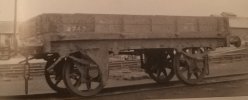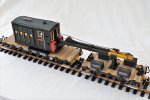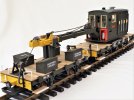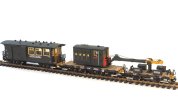David1226
Registered
To add variety and interest to the Claptowte Railway rolling stock, I had always intended to add a travelling crane, with associated match truck, to support the crane jib while in transit. To that end, over the years, I had collected various donor vehicles and components to construct such vehicles. The crane is based on the LGB Toy Train crane, with an additional Toy Train stake wagon to increase the length of the frame and decking. The match truck is based on a single Toy Train stake wagon.
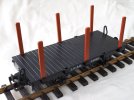
The stakes are removed as surplus to requirement. The wagon used for this model was actually red. The only addition, at this stage, was the addition of Garden Railway Specialists (GRS) etched brass lamp irons to each buffer beam. The sign writing along each side was removed with a light sanding with fine wet or dry paper.
The plastic wheels were replaced with Al Kramer bright nickel plated, solid turned brass wheels, imported from the US, which I have adopted as standard across the entire Claptowte Railway rolling stock fleet. These are really heavy and provide a good low centre of gravity.
The first addition was to fit a hand brake lever, fabricated from plastic tube and rod, with a brass wire handle, fixed to one end of the wagon side. I attached Toy Train footsteps to each end of the model, from the spares box, saved from previous conversions. Low hand grabs were added, from bent brass handrail wire, adjacent to each footstep. I then added raised bars to each end of the deck, to retain the crane hook when in the travelling position. The bars and supports are made by cutting down surplus Toy Train brake gear, from the spares box, again salvaged from earlier conversions, glued to plasticard base plates, embellished with 1.0mm self adhesive pearl gems, to represent bolt heads.
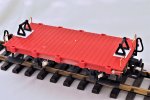
The next fabrication to be added was the support cradle for the crane’s jib, when in the transport position. The structure was constructed from plasticard. The cradle was lined with 3.0mm plasticard, scribed and grained to represent wooden timbers for the jib to rest on. I drilled shallow holes in the ‘timbers’ into which I placed more of the 1.0mm pearl gems, to represent recessed fixing bolt heads. I added more of the pearl gems to the base plate of the jib support, again to represent bolt heads.
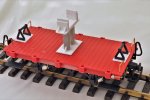
The last addition to the match truck was to add four storage bins. Again these were fabricated from plasicard which was scribed to represent grainy wooden planks. The bin handles were made from bent brass wire and the hinges from thin plastic rod.
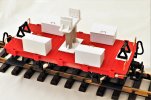
That completes the construction of the Match Truck. Below are a couple of views of the truck supporting the crane jib.
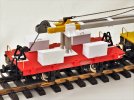
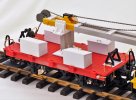
The various component parts were sprayed with grey plastic primer and then painted before final assembly. The livery is Engineering Olive Green. The signs were printed on my ink jet printer onto white card. After cutting to size, I ran a black permanent marker pen along the cut edges, to blacken them. For continuity of appearance, this was the same method that I used to sign the Tool/Mess Van that I had already constructed to accompany the travelling crane. Pics of the finished model below.
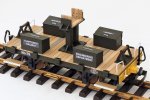
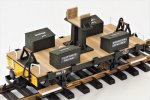
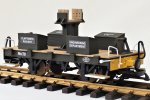
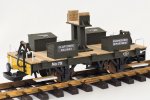
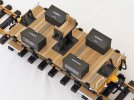
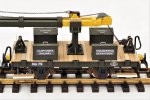
David

The stakes are removed as surplus to requirement. The wagon used for this model was actually red. The only addition, at this stage, was the addition of Garden Railway Specialists (GRS) etched brass lamp irons to each buffer beam. The sign writing along each side was removed with a light sanding with fine wet or dry paper.
The plastic wheels were replaced with Al Kramer bright nickel plated, solid turned brass wheels, imported from the US, which I have adopted as standard across the entire Claptowte Railway rolling stock fleet. These are really heavy and provide a good low centre of gravity.
The first addition was to fit a hand brake lever, fabricated from plastic tube and rod, with a brass wire handle, fixed to one end of the wagon side. I attached Toy Train footsteps to each end of the model, from the spares box, saved from previous conversions. Low hand grabs were added, from bent brass handrail wire, adjacent to each footstep. I then added raised bars to each end of the deck, to retain the crane hook when in the travelling position. The bars and supports are made by cutting down surplus Toy Train brake gear, from the spares box, again salvaged from earlier conversions, glued to plasticard base plates, embellished with 1.0mm self adhesive pearl gems, to represent bolt heads.

The next fabrication to be added was the support cradle for the crane’s jib, when in the transport position. The structure was constructed from plasticard. The cradle was lined with 3.0mm plasticard, scribed and grained to represent wooden timbers for the jib to rest on. I drilled shallow holes in the ‘timbers’ into which I placed more of the 1.0mm pearl gems, to represent recessed fixing bolt heads. I added more of the pearl gems to the base plate of the jib support, again to represent bolt heads.

The last addition to the match truck was to add four storage bins. Again these were fabricated from plasicard which was scribed to represent grainy wooden planks. The bin handles were made from bent brass wire and the hinges from thin plastic rod.

That completes the construction of the Match Truck. Below are a couple of views of the truck supporting the crane jib.


The various component parts were sprayed with grey plastic primer and then painted before final assembly. The livery is Engineering Olive Green. The signs were printed on my ink jet printer onto white card. After cutting to size, I ran a black permanent marker pen along the cut edges, to blacken them. For continuity of appearance, this was the same method that I used to sign the Tool/Mess Van that I had already constructed to accompany the travelling crane. Pics of the finished model below.






David


